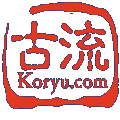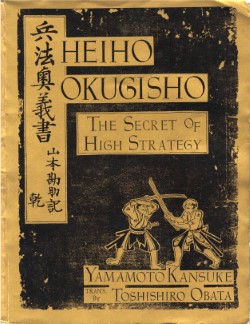Heiho Okugisho: The secret of high strategy is a translation of a classical martial text written by Yamamoto Kansuke (1493-1561) and translated by the descendant of the man who later compiled a larger, more famous work called the Koyogunkan, Toshishiro Obata, and his son, Michishiro. Obata is a former student of Gozo Shioda, founder of the Yoshinkan, and he presently lives in the Los Angeles area where he teaches swordsmanship and a number of other arts. He is also involved in martial arts films and uses his budo skills to good effect in this endeavor (you may have seen him in “Teenage Mutant Ninja Turtles” where he played one of the bad guys).
The book is a full-sized reproduction of the 1804 edition and is one of a number of very interesting titles available from W.M. Hawley Publications, who have long published works of value to people interested in Japanese swords and other weapons. I found the book (mine is from the second printing) to be a very good rendition of the original text. The translators have provided the original text and illustrations on the right-hand pages and the equivalent in English (again, with the illustrations) on the left in a manner akin to many scholarly books. For those able to read Japanese, this provides an immediate means of checking the translation with the original, a very helpful thing to be sure. It’s not always easy, though, because the cursive style of the characters can be hard to follow.
Generally speaking, I have no differences of opinion with the English wording. A few minor quibbles, such as “handle” instead of “hilt” when speaking of swords and a few wordings I think are a bit strange, but nothing to detract from the work’s accuracy or intent. The Obatas have done an excellent job.
The book adheres to the original organization of material and can be used as a model for future such translations. The first chapter is an explanation of the nature of strategy. Chapter two deals with various techniques and tactics for close-quarter combat (unarmed, with swords, staffs, spears and glaives, and use of the bow and matchlock gun); oddly enough, the illustrations for staff and spear combat depict men in Chinese-style clothing. The third chapter is, to my mind, one of the most interesting as it discusses the psychological, philosophical and, again, tactical and strategic aspects of personal combat. Chapters four and five are, respectively, about the use of terrain and fighting under different natural conditions. At first glance they may seem to have little relevance to modern training methods or purposes. Closer reflection, however, reveals a considerable degree of insight and, I believe, much of value, in terms of general sensitivity to one’s surroundings. Aside from the historical interest of the material, it seems quite pertinent to me in terms of self-defense.
All in all, a very good book. Why not get a copy? I think you’ll find it interesting.

